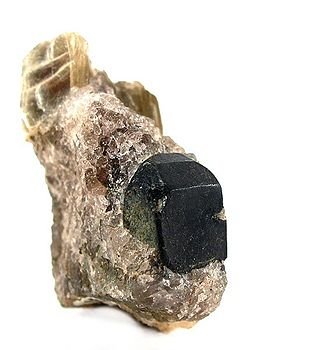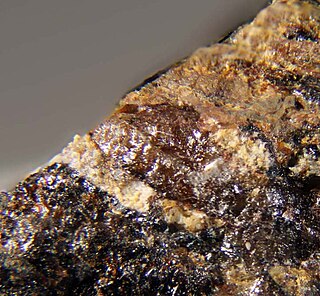Related Research Articles

Triphylite is a lithium iron(II) phosphate mineral with the chemical formula LiFePO4. It is a member of the triphylite group and forms a complete solid solution series with the lithium manganese(II) phosphate, lithiophilite. Triphylite crystallizes in the orthorhombic crystal system. It rarely forms prismatic crystals and is more frequently found in hypidiomorphic rock. It is bluish- to greenish-gray in color, but upon alteration becomes brown to black.

Phosphate minerals are minerals that contain the tetrahedrally coordinated phosphate anion, sometimes with arsenate and vanadate substitutions, along with chloride (Cl−), fluoride (F−), and hydroxide (OH−) anions, that also fit into the crystal structure.

Abenakiite-(Ce) is a mineral of sodium, cerium, neodymium, lanthanum, praseodymium, thorium, samarium, oxygen, sulfur, carbon, phosphorus, and silicon with a chemical formula Na26Ce6(SiO3)6(PO4)6(CO3)6(S4+O2)O. The silicate groups may be given as the cyclic Si6O18 grouping. The mineral is named after the Abenaki, an Algonquian Indian tribe of New England. Its Mohs scale rating is 4 to 5.

Gedrite is a crystal belonging to the orthorhombic ferromagnesian subgroup of the amphibole supergroup of the double chain inosilicate minerals with the ideal chemical formula Mg2(Mg3Al2)(Si6Al2)O22(OH)2.

Cyrilovite (NaFe33+(PO4)2(OH)4·2(H2O)) is a hydrous sodium iron phosphate mineral. It is isomorphous and isostructural with wardite, the sodium aluminium counterpart.

Hureaulite is a manganese phosphate with the formula Mn2+5(PO3OH)2(PO4)2·4H2O. It was discovered in 1825 and named in 1826 for the type locality, Les Hureaux, Saint-Sylvestre, Haute-Vienne, Limousin, France. It is sometimes written as huréaulite, but the IMA does not recommend this for English language text.
This list gives an overview of the classification of non-silicate minerals and includes mostly International Mineralogical Association (IMA) recognized minerals and its groupings. This list complements the List of minerals recognized by the International Mineralogical Association series of articles and List of minerals. Rocks, ores, mineral mixtures, not IMA approved minerals, not named minerals are mostly excluded. Mostly major groups only, or groupings used by New Dana Classification and Mindat.
This list gives an overview of the classification of minerals (silicates) and includes mostly International Mineralogical Association (IMA) recognized minerals and its groupings. This list complements the List of minerals recognized by the International Mineralogical Association series of articles and List of minerals. Rocks, ores, mineral mixtures, non-IMA approved minerals and non-named minerals are mostly excluded.

Uranocircite or Uranocircite-II is a uranium mineral with the chemical formula: Ba(UO2)2(PO4)2·10H2O. Uranocircite-I was discredited (the IMA-CMNMC published 'The New IMA List of Minerals', September 2012). It is a phosphate mineral which contains barium and is a green to yellow colour. It has a Mohs hardness of about 2.

Ephesite is a rare member of the mica silicate mineral group, phyllosilicate. It is restricted to quartz-free, alumina rich mineral assemblages and has been found in South African deposits in the Postmasburg district as well as Ephesus, Turkey.

Hollandite (chemical formula: Ba(Mn4+6Mn3+2)O16) is a manganese oxide mineral. Its structure consists of double chains of MnO6 octahedra delimiting 2 × 2 tunnels. The electrostatic charge created by the Mn3+ for Mn4+ substitution is balanced by cations in the tunnels. Their nature determines the mineral species: Ba for hollandite, K for cryptomelane, Pb for coronadite, Sr for strontiomelane, Tl for thalliomelane, and Na for manjiroite. Pure species are rare and most 2 × 2 tectomanganates contain mixtures of several types of tunnel cations.

Zirsilite-(Ce) is a very rare mineral of the eudialyte group, with formula (Na,□)12(Ce,Na)3Ca6Mn3Zr3NbSi(Si9O27)2(Si3O9)2O(OH)3(CO3)·H2O. The original formula was extended to show the presence of cyclic silicate groups and the presence of silicon at the M4 site, according to the nomenclature of the eudialyte group. Zirsilite-(Ce) differs from carbokentbrooksite in cerium-dominance over sodium only. Both minerals are intimately associated. The only other currently known representative of the eudialyte group having rare earth elements (in particular cerium, as suggested by the "-Ce)" Levinson suffix in the name) in dominance is johnsenite-(Ce).
Dualite is a very rare and complex mineral of the eudialyte group, its complexity being expressed in its formula Na
30(Ca,Na,Ce,Sr)
12(Na,Mn,Fe,Ti)
6Zr
3Ti
3MnSi
51O
144(OH,H
2O,Cl)
9. The formula is simplified as it does not show the presence of cyclic silicate groups. The name of the mineral comes from its dual nature: zircono- and titanosilicate at once. Dualite has two modules in its structure: alluaivite one and eudialyte one. After alluaivite and labyrinthite it stands for third representative of the eudialyte group with essential titanium.
Reederite-(Y) is a rare mineral with the formula (Na,Mn,Fe)15(Y,REE)2(CO3)9(SO3F)Cl. It is the only known mineral with fluorosulfate (fluorosulfonate). "REE" in the formula stands for rare earth elements other than yttrium, that is mostly cerium, with traces of neodymium, dysprosium, lanthanum and erbium. The formula also includes a Levinson suffix "-(Y)" pointing to the dominance of yttrium at the corresponding site. Reederite-(Y) crystallizes in the hexagonal crystal system with the space group P6, rarely seen among minerals.
Zadovite is an extremely rare mineral with formula BaCa6[(SiO4)(PO4)](PO4)2F. Together with its vanadium-analogue, aradite, zadovite occur in paralavas (type of pyrometamorphic rocks). Both minerals have structures similar to nabimusaite, and these three minerals occur in the Hatrurim Formation of Israel. Structure of all three minerals is related to that of hatrurite. Minerals combining barium, phosphorus and silicon together are scarce.

Jinshajiangite is a rare silicate mineral named after the Jinshajiang river in China. Its currently accepted formula is BaNaFe4Ti2(Si2O7)2O2(OH)2F. It gives a name of the jinshajiangite group. The mineral is associated with alkaline rocks. In jinshajiangite, there is a potassium-to-barium, calcium-to-sodium, manganese-to-iron and iron-to-titanium diadochy substitution. Jinshajiangite is the iron-analogue of surkhobite and perraultite. It is chemically related to bafertisite, cámaraite and emmerichite. Its structure is related to that of bafertisite. Jinshajiangite is a titanosilicate with heteropolyhedral HOH layers, where the H-layer is a mixed tetrahedral-octahedral layer, and the O-layer is simply octahedral.
Ferro-ferri-hornblende is an amphibole-supergroup mineral with the formula ☐Ca2(Fe2+4Fe3+)(Si7Al)O22(OH)2. It contains essential vacancy (☐). It was discovered in the Traversella mine, Canavese, Torino, Piedmont, Italy.

Wilancookite is a very rare and complex beryllium phosphate with the chemical formula (Ba,K,Na)8(Ba,Li,[ ])6Be24P24O96·32H2O. Wilancookite was discovered in pegmatite of the Lavra Ponte do Piauí complex, Jequitinhonha, Minas Gerais, Brazil.
References
- ↑ Warr, L.N. (2021). "IMA–CNMNC approved mineral symbols". Mineralogical Magazine. 85 (3): 291–320. Bibcode:2021MinM...85..291W. doi: 10.1180/mgm.2021.43 . S2CID 235729616.
- 1 2 Cámara, F., Bittarello, E., Ciriotti, M.E., Nestola, F., Radica, F., and Bracco, R., 2015. Fluorcarmoite-(BaNa), IMA 2015-062. CNMNCNewsletter No. 27, October 2015, 1229; Mineralogical Magazine 79, 1229–1236
- 1 2 "Fluorcarmoite-(BaNa): Fluorcarmoite-(BaNa) mineral information and data". Mindat.org. Retrieved 2016-03-12.
- ↑ "Ferri-arrojadite-(BaNa): Ferri-arrojadite-(BaNa) mineral information and data". Mindat.org. Retrieved 2016-03-12.
- ↑ Hatert, F., Mills, S.J., Pasero, M., and Williams, P.A., 2013. CNMNC guidelines for the use of suffixes and prefixes in mineral nomenclature, and for the preservation of historical names. European Journal of Mineralogy 25, 113-115
- ↑ Chopin, C., Oberti, R., and Cámara, F. 2006. The arrojadite enigma: II. Compositional space, new members and nomenclature of the group. American Mineralogist 91, 1260-1270.